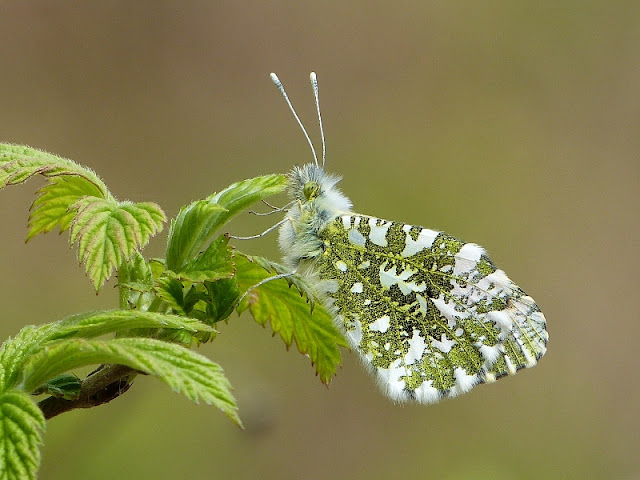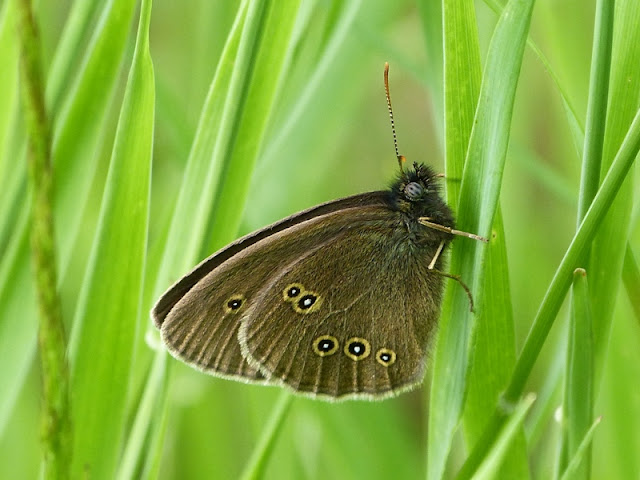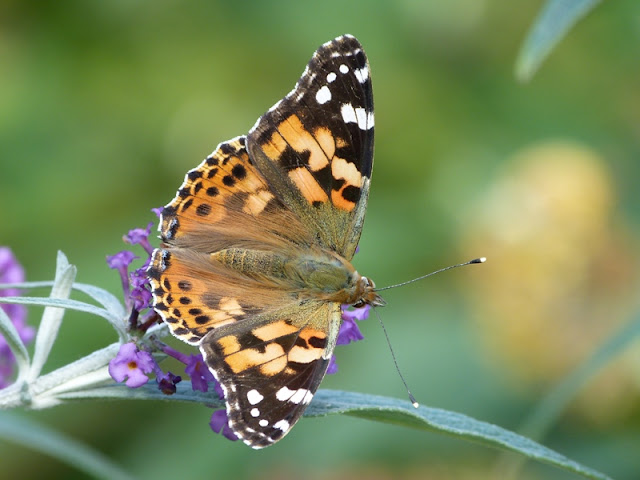It has been almost three years since we moved to our house in the Scottish Borders. We have actually owned the house since 2016, but only popped down at weekends while we were having building work done. We finally moved in two days before lockdown for the Covid pandemic, which means I have been mostly working from home, allowing me pop out at lunchtime to look for butterflies.
I have a set lunchtime dog walk, past all the best butterfly spots and around a little path through my meadow and each day I walk the route I keep a note of the butterflies I have seen.
I have just had a look at all of my sightings over the last three years to see if there are any increases in butterfly numbers, which may be a result of the work I have done to try to enhance the place for butterflies.
I have seen 19 different species of butterflies here, which I am very pleased about. The numbers of some of the more common species seem to fluctuate quite a bit, so don't really show anything. Each year I have seen good numbers of Orange Tips and 2022 was a particularly good year for Green-veined Whites. Small White had a really poor year in 2020, a great year in 2021 and an average year last year! Large Whites tend to be seen in much smaller numbers than the other whites, but they had a particularly good year in 2021. I am expecting to see a good number this year, as I planted nasturtiums last year and the house is currently covered in Large White chrysalises!
Ringlet and Meadow Brown numbers have increased year on year. Possibly these grassland species are benefiting from the management of the meadow area and I have seen them in the area that had been a spruce plantation, so they are certainly benefiting from the grass that is growing amongst the young broad leaves there.
The other grassland species, the Small Heath, hasn't done so well. Each year I have only seen one or two here. It seems strange, as they are really common in the valley above the house and I would have thought the habitats here are perfect for them.
The number of Small Tortoiseshells has gone up and down. 2021 was particularly good, but numbers dropped back down last year. I think the cool and cloudy spring didn't help them this year. In the past I have found several groups of caterpillars on nettles, but I didn't find any this spring.
However, the Peacock, which has a similar life cycle to the Small Tortoiseshell did really well in both 2021 and 2022. I did find a couple of groups of caterpillars, so they were possibly more successful breeding. In 2019 I recorded 48 Peacocks, in 2020 99 Peacocks, 2021 I saw 196 and last year I recorded 192 Peacocks. Maybe the numbers reflect how my Buddleia bushes have grown over the last four years.
Red Admirals have been remarkably consistent and I have seen almost the same number each of the last three years. In late summer the Buddleia bushes are covered with them and they remain here long after the first frosts.
Commas are not considered a common butterfly in Southern Scotland, but their numbers have increased year on year here. Since 2018 the numbers I have seen each year were 9, 20, 25, 38 and 58. It is lovely to see them doing so well and I hope their numbers continue to increase.
The number of Painted Ladies varies considerably, as it does all over the country. Last year was the best year I have seen here, with 11 sightings, but in 2021 I didn't see any at all.
In 2020 I was happy to see 13 Dark Green Fritillaries feeding on thistles in my meadow. I thought that my new cutting regime was really paying off, but in 2021 I only saw 3 and last year only 5, despite there being really good numbers on the hill above the house.
I was really excited in 2020 to see a Small Pearl-bordered Fritillary in the meadow. Unfortunately, I didn't see any here in 2021, but last year I saw another here for a few days. There are good numbers in the valley above our house and we have a lot of violets growing in our woodland, so I am hopeful I may continue to see them here in future years.
I am really pleased that the number of Small Coppers I have seen has increased over the last three years. In 2020 I only saw 1, in 2021 I saw 8 and last year I saw 17. I don't really understand why I don't see more as the place is covered in Common Sorrel and Dock Leaf. Maybe their numbers will continue to increase.
I saw one Large Skipper zipping around the meadow in 2020 and another in 2022. I have seen them in the valley above the house, but only one or two.
I didn't see any Small Skippers in 2020, but I was excited to see 7 in 2021 and 17 last year. I am hoping that they will like the way I am managing the meadow, but I am always a bit worried that I may be destroying their eggs when I cut the vegetation in the autumn. There are areas that I leave uncut in the hope that it will help.
I have been amazed that every year since 2019 I have seen a Scotch Argus on our land. A couple of years I have recorded 2, but I can't be sure they were different individuals. Strangely, we don't have any Purple Moor Grass here, but I have seen one egg laying on another species of grass. The other strange thing is that there are no records of any Scotch Argus anywhere near. I can only assume that there is a colony somewhere nearby that hasn't been recorded.
The other really exciting record has been Northern Brown Argus. I saw one in 2020 and another here in 2022. There is a good colony in the valley about 800 metres above the house, but I have always understood that Northern Brown Argus don't travel any distance. Even more exciting last year was that I found Northern Brown Argus eggs on the Rockrose that I have planted on a little bank near the house. I am really looking forward to seeing if I now have my own little colony here and I am already planning to extend the area of Rockrose.
There are two species of butterfly that I watched arrive and spread across East Lothian when we lived there. Speckled Woods arrived in 2010 and are now a really common site across the county. Wall Browns arrived in 2011 and they have also spread right along the coast and along river valleys and are now seen regularly. It has always seemed odd not having either species here, but being further from the coast, we have a shorter season, so they haven't made their way here yet. However, last year Speckled Woods were recorded about three miles from here and there was a Wall Brown seen in the village less than a mile from here. So, both species are spreading in this direction and I live in hope that I may see them later in 2023.
There has also been a lot of excitement here in the Borders with more and more sightings of White-letter Hairstreaks and Purple Hairstreaks, particularly in the east of the county. White-letter Hairstreaks are heading along the river valleys in this direction and there used to be a colony of Purple Hairstreaks just the other side of the valley from here. So, there is much to look forward to.












